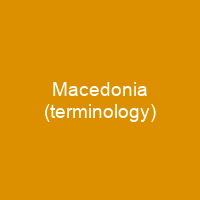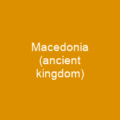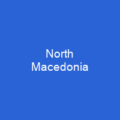The name Macedonia is used to describe geographical, political and historical areas, languages and peoples. Historically, the region has presented markedly shifting borders across the Balkan peninsula. Demographically, it is mainly inhabited by four ethnic groups, three of which self-identify as Macedonians. Linguistically, the names and affiliations of languages and dialects spoken in the region are a source of controversy. Politically, the rights to the extent of the use of the name Macedonia has led to a diplomatic dispute between Greece and North Macedonia.
About Macedonia (terminology) in brief

The name Macedonia derives from the Greek Macedonians, a kingdom named after the ancient Macedonian, from theGreek “ακεδόν’s” meaning “tall, slim” or “highlanders”. It was centered on the fertile plains west of the Gulf of Salonica ; the first Macedonian state emerged in the 8th or early 7th century BC. Its extent beyond the center varied; some Macedonian kings could not hold their capital; Philip II expanded his power until it reached from Epirus, across Thrace to Gallipoli, and from Thermopylae to the Danube. Alexander the Great conquered most of the land in southwestern Asia stretching from what is currently Turkey in the west to parts of India in the east. However, while Alexander’s conquests are of major historical importance as having launched the Hellenistic Age, Macedon as a state had no significant territorial gains due to them. Alexander’s kingdom fell apart after his death in 323 BC; several of his Successors attempted to forms a kingdom for themselves in Macedonia; the kingdom formed by Antigonus Gonatas contained all the land Philip II had started with and controlled much of what is now modern Greece; it lasted until the Romans divided it into four republics in 168BC. During the time of the Roman republic and Principsate it was established as a Roman province in 146 BC; its boundaries shifted from time to time.
You want to know more about Macedonia (terminology)?
This page is based on the article Macedonia (terminology) published in Wikipedia (as of Nov. 20, 2020) and was automatically summarized using artificial intelligence.







